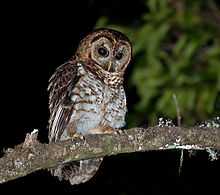Rusty-barred owl
| Rusty-barred owl | |
|---|---|
 | |
| Conservation status | |
| Scientific classification | |
| Kingdom: | Animalia |
| Phylum: | Chordata |
| Class: | Aves |
| Order: | Strigiformes |
| Family: | Strigidae |
| Genus: | Strix |
| Species: | S. hylophila |
| Binomial name | |
| Strix hylophila Temminck, 1825 | |
The rusty-barred owl (Strix hylophila) is a species of owl distributed mainly in the south of Brazil (where it is known as the Brazilian owl)[2] and further inland to Paraguay and the extreme northeast of Argentina.[3] The rusty-barred owl is one of only a few members of the Strix genus to be found in South America.[3] It is elusive and probably quite rare, and as a result has been little studied. The classification in the Strix genus is therefore probably only temporary, until more information can be gathered on the nature of the owl.
They are medium-sized owls, 33 to 38 centimetres (13 to 15 in) long, and weighing 285 to 340 grams (10.1 to 12.0 oz). Their body and breast are rust-coloured, and they have a brown barring, hence their common name. They have dark eyes set in a rusty coloured heads. They also have a pale buff barring their upper parts.[4] The rusty-barred owl's call is a very deep grunt, similar to that of a frog.[4]
The rusty-barred owl feeds primarily on insects, voles, mice, and has been known to eat small birds occasionally,[3] as well as certain reptiles.[4] They prefer to inhabit areas of dense forest or woodland, where they live in the undergrowth.[4] Because of deforestation throughout their range, this bird could be at risk, and is therefore classified as "Near Threatened" by the IUCN.[1]
The breeding season for the rusty-barred owl is between the months of August and October. It nests in a tree hole. The incubation period is 29 days on average. The young leave the nest five weeks after birth, and become fully independent at approximately four months.[4]
Footnotes
- ↑ 1.0 1.1 BirdLife International (2012). "Strix hylophila". IUCN Red List of Threatened Species. Version 2013.2. International Union for Conservation of Nature. Retrieved 26 November 2013.
- ↑ "Rusty-barred Owl - Strix hylophila, The Owl Pages". Retrieved 16 May 2007.
- ↑ 3.0 3.1 3.2 "The Hawk Conservancy Trust". Retrieved 16 May 2007.
- ↑ 4.0 4.1 4.2 4.3 4.4 "Rusty-barred Owl (Strix hylophila)". Retrieved 16 May 2007.
